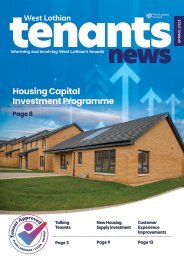Livingston City Status Bid
- No tags were found...
Create successful ePaper yourself
Turn your PDF publications into a flip-book with our unique Google optimized e-Paper software.
PLANNING HISTORY AND PROGRESS<br />
<strong>Livingston</strong> New Town was designated in April 1962<br />
to cover 2,700ha, the fourth of the five New Towns<br />
to be designated in Scotland.<br />
In the six decades of its existence it has proved<br />
highly successful in achieving its original objectives.<br />
Its first objective was to create a focal point for<br />
industrial expansion in Central Scotland. After<br />
initially establishing itself as an important location<br />
for general industry, <strong>Livingston</strong> has gone on to<br />
become a major attraction for high-technology<br />
employers onto sites such as the Alba Campus.<br />
It has provided a central location for one of<br />
Scotland’s major retail centres, a district general<br />
hospital that provides a comprehensive range of<br />
services for the people of Lothian and beyond,<br />
the home of <strong>Livingston</strong> FC and West Lothian<br />
College, and an array of recreational facilities which<br />
are of benefit to the whole of Central Scotland.<br />
More fundamentally it has become the engine of<br />
locally generated economic development. Another<br />
objective was to accommodate the large-scale<br />
population growth predicted in Central Scotland<br />
at that time and the population pressures from<br />
Glasgow. <strong>Livingston</strong> is now by far the largest town<br />
in West Lothian and second only to Edinburgh in<br />
the Lothians.<br />
<strong>Livingston</strong> may be a new town but its story goes<br />
back much further than 1962. Leving built a castle<br />
here around 1124. His castle was surrounded by<br />
houses and steadings. It was called Leving’s town,<br />
over the years becoming known as <strong>Livingston</strong>.<br />
In the 19th century, oil shale brought wealth to<br />
West Lothian. <strong>Livingston</strong> was a centre of the shale<br />
industry. There were mines and an oil works at<br />
<strong>Livingston</strong> Station. There was another mine at<br />
Newfarm which is now the site of the Lanthorn<br />
Community Centre. An aerial ropeway was built to<br />
carry the shale from Newfarm to the Oakbank Oil<br />
works, about two or three miles away, where it was<br />
processed into crude oil.<br />
By 1962, the area that would be designated as<br />
<strong>Livingston</strong> new town included the villages of<br />
Bellsquarry, <strong>Livingston</strong> Village and the largest,<br />
<strong>Livingston</strong> Station, which was home to around<br />
1,400 residents.<br />
<strong>Livingston</strong> has always been proud of its heritage<br />
and features of early <strong>Livingston</strong> were incorporated<br />
into the town. Historic buildings were renovated to<br />
become community facilities, whilst new housing<br />
was built alongside miners’ cottages.<br />
INNOVATION<br />
<strong>Livingston</strong> is widely recognised as one of the country’s leading<br />
areas in the manufacturing and service industry sectors. Some<br />
of the world’s leading companies are located within <strong>Livingston</strong><br />
representing the software manufacturing, biotech, information<br />
technology and service sectors.<br />
#<br />
LIVINGSTONCITYBID<br />
6


















